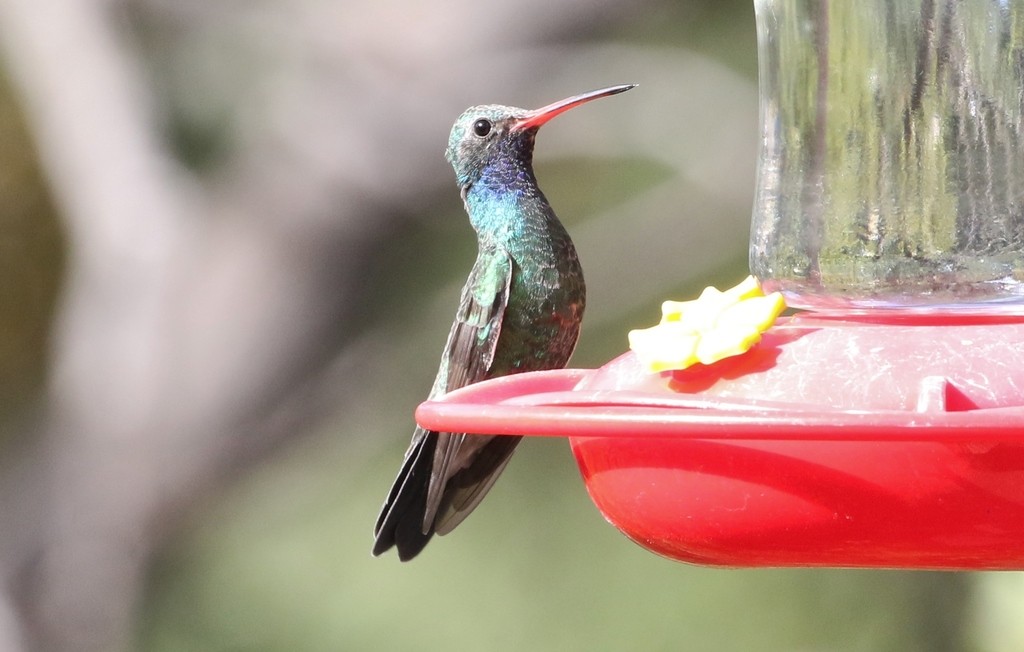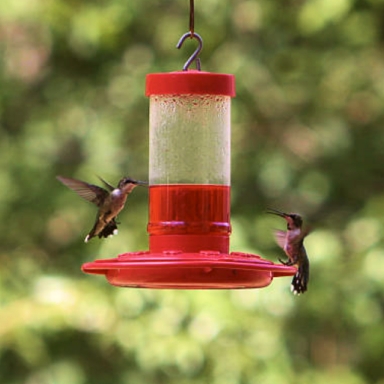Broad-billed Hummingbird
A species of Broad-billed Hummingbirds Scientific name : Cynanthus latirostris Genus : Broad-billed Hummingbirds
Broad-billed Hummingbird, A species of Broad-billed Hummingbirds
Botanical name: Cynanthus latirostris
Genus: Broad-billed Hummingbirds
 Photo By silversea_starsong , used under CC-BY-NC-4.0 /Cropped and compressed from original
Photo By silversea_starsong , used under CC-BY-NC-4.0 /Cropped and compressed from original Description
The broad-billed hummingbird is a small-sized hummingbird at about 8–10 cm (3.1–3.9 in) long. It weighs only 3–4 grams, with the male weighing slightly more than the female. The wingspan of the hummingbird is about 13 cm (5.1 in). It has a long, bright reddish coloured bill that has a black tip. The birds are metallic green dorsally with more dull colouring on the crown and forehead. The hummingbird is sexually dimorphic, with the adults appearance varying significantly. The male is dark green with white undertail-coverts and a blue throat. The adult males tail is blackish-blue and broad. The flight feathers are brownish-gray. The adult female has a pale belly and has a white eyestripe behind her eye. Her tail feathers are white-tipped. The bill of the male is shorter but brighter red. As for size, both the juvenile and adult males have larger wings and tails than the female. The colouring of the juveniles tends to resemble the adult female. With time, the bill of the juvenile males will redden, and iridescent feathers will appear on its throat. Unlike the females, the juvenile males do not have a white-tipped tail. The hatchings have a brown body and orange downy feathers and an orange bill. Not much is known about hatchlings, but in captivity, the juvenile birds have been seen to have adult plumage within 6–8 months. 
Size
8-10 cm (3-4 in)
Colors
Brown
Black
Green
Red
White
Blue
Life Expectancy
6.8-8.8 years
Nest Placement
Tree
Clutch Size
2 - 3 eggs
Feeding Habits
Broad-billed Hummingbird consume nectar and insects, preferentially sourcing from diverse flowering species including agaves and milkweed, and are known to visit feeders. They exhibit traplining and territorial behaviors, adjusting foraging strategies with floral seasonality. Additionally, broad-billed Hummingbird show a propensity for red or yellow flowers, consume insects through aerial catch or from vegetation, and display peak feeding activity in mornings and late afternoons.
Habitat
Broad-billed Hummingbird predominantly inhabits stream corridors within foothill oak woodlands and canyon environments in the United States, thriving at elevations below 6,500 feet. Post-monsoon, these birds may forage at altitudes up to 9,800 feet in mountain meadows. Their range extends into Mexico, where they adapt to varied habitats including lowland thorn and tropical deciduous forests, as well as higher mountain canyons. Vegetation that plays a critical role in their habitat includes Arizona sycamore, Fremont cottonwood, and desert willow, among other plant species that thrive in these regions.
Nest Behavior
Broad-billed Hummingbird exhibits a nesting behavior characterized by females choosing nest sites and constructing the nests. Egg-laying patterns are not detailed, but parental care involves the female exclusively managing the incubation and rearing of the young. Nests are often positioned to blend with natural debris, enhancing their concealment.
Nest Characteristics
Broad-billed Hummingbird tends to nest approximately 3 feet above the ground on downward-hanging tree branches, frequently near water or rocks. The females construct a petite cup-shaped nest, approximately 1 inch in height and 0.75 inches in diameter, using bark strips, grasses, leaves, and spiderwebs, with an outer decoration of plant matter for potential camouflage.
Dite type
Nectivorous
Migration Overview
The breeding populations of C. l. latirostris in the United States, Sonora and Nuevo León are all migratory. Not enough information is known about the migration but it's believed that the birds fly deeper south into Mexico, into Guerrero and Baja California Sur. Most populations in Mexico are resident, unless they reside in the extreme north. The Northern populations migrate south in the beginning of November, and return in early March. There have been rare sightings in the fall and winter months in Southern California, Texas and even rarely in Oregon, Idaho, Colorado and the East Coast. An abundance map of broad-bill hummingbirds has been produced on eBird. 
General Info
Feeding Habits
Bird food type
Bird Feeder Type

Nectar Feeder
Behavior
The broad-billed Hummingbird exhibits a distinct courting behavior; males call from perches and engage in a flight display to entice females. They execute a pendulum-style swing, and sometimes ascend sharply, potentially chasing the female thereafter. These displays can also serve as a male rivalry deterrent. Post-mating, males disengage from the breeding process while females take on the responsibilities of nest-building, egg incubation, and chick-rearing until their independence. Broad-billed Hummingbird engages in post-nesting nomadic behavior, often ascending to higher elevations in search of flora or feeders before migrating south. Some remain resident near the U.S.-Mexico border.
Distribution Area
In the United States, C. l. latirostris lives along streamsides and oak woodlands. It prefers areas with streamside groves and dense vegetation, as well as open oak woodlands in lower canyons. It favours living in areas with Arizona sycamore (Platanus wrightii), Fremont cottonwoods (Populus fremontii), and mesquite. In Mexico, specimens have been collected at nearly every elevation above sea level, even from 1494 to 3048 meters high. Along the Pacific coast, the broad-billed hummingbird is known to be a common resident of arid thorn forests, tropical deciduous forests and riparian gallery forests. During breeding season, the broad-billed hummingbird is common in desert canyons and low mountain oak woodlands. It's found in the Southwest United States through to central Mexico. It has been noted breeding in southeast Arizona, southwest New Mexico and rarely in southwest Texas. There have also been rare sightings across the continent, including in Arkansas. In the state of Sonora, Mexico, it is the most common hummingbird. 
Species Status
Not globally threatened.
Scientific Classification
Phylum
Chordates Class
Birds Order
Swifts and hummingbirds Family
Hummingbirds Species
Broad-billed Hummingbird